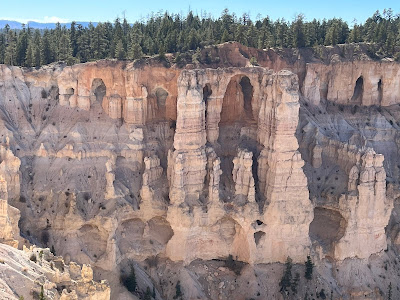Hoodoos are the name given to the rock spires in Bryce Canyon. These fairytale-like spires rise below the cliffs of the Paunsaugunt Plateau. Much like my kids and I used to find shapes in the clouds over Kansas, tourists find "characters" in the spires formed in the soft limestone into shapes that look like sand castles, Gothic cathedrals and princess lairs. But modern-day visitors aren't the first ones to find them intriguing. The Paiute tribe, who came through the area on seasonal hunting and gathering expeditions, attributed them to the Legend People transformed by Coyote into rocks.
It's not just the shapes that are almost as individual as fingerprints. Hoodoos don't grow like trees but are eroded out of the cliffs where rows of narrow walls form. These thin walls of rock are called fins. Frost-wedging enlarges cracks in the finds, creating holes or windows. As windows grow, their tops eventually collapse, leaving a column. Rain further dissolves and sculpts the limestone pillars into bulbous spires called hoodoos. The climatic balance between snow and rain ensures that new hoodoos will emerge, while other become reduced to lumps of clay.
The colors also change in sun and shadow, revealing the different hues of reds, oranges, pinks, yellows and creams.
Bryce Point provided a lesson in those differences. Bryce Canyon was established in 1928. It includes 35,835 acres.
Actually, before you even arrive at Bryce Canyon proper, there's a little bit of fairytale magic. We passed through two man-made tunnels as we traveled from St. George, Utah, through the Red Canyon to Bryce Canyon.
On June 1, 1925, a 315-car caravan led by Governor George Dern, arrived at the Red Canyon tunnels to celebrate the opening of Utah National Park, later renamed Bryce Canyon National Park. A flower-strewn gate closed the entrance to the second tunnel and a banner proclaimed, "Welcome to Utah's Fairyland."
The tunnels were the brainchild of W.J. Humphrey, Powell National Forest supervisor, who, upon visiting Bryce Canyon in 1915, said this:
"We came upon what I have always considered the most beautiful piece of natural scenery on the face of the earth."
 |
| Randy and Smoky |
As we first arrived, the hoodoos seemed to grow out of the rocks like the ponderosa pines of the Dixie National Forest.
 |
| Farview Point, Elevation 8819 |
At Agua Canyon (elevation 8800) two prominent hoodoos command attention.
On the left is the taller of the two towers, "The Hunter." To the right is a hoodoo commonly referred to as the "Rabbit." In the early years of Bryce Canyon National Park, an effort was made to name many of the more prominent hoodoos. However, through the years, many of these have fallen or partially fallen so that they look nothing like the things they were originally named for. As a result, hoodoos are no longer being named. Navajo Mountain looms on the distant horizon.
 |
| Agua Canyon overlook |
One of my favorite stops was the Natural Bridge. The natural arch is 85 feet
long and 125 feet high. Its bright rusty red contrasts with the green of
the trees below and the deep blue of the sky.
At the Bryce Point scenic outlook, one side looked like a sand castle to me.
But, turn just 90 degrees or so, and the coloring and shapes changed markedly.
Maybe that long-ago Utah governor had it right when he called the park "a fairyland." Fairyland Canyon seemed an appropriate name for this outlook.
As a side note, while at Bryce Canyon, we stayed at Ruby's Inn (now a Best Western). Ruby's Inn has been hosting guests to the area for more than 100 years. In 1916, Reuben C. (Ruby) Syrett brought his family to the wilds of southern Utah and established a ranch. A few weeks after his arrival, another rancher told Ruby of the canyon called Bryce. They also began telling people about the beauty of the canyon. In 1919, Ruby obtained permission from the state to build a lodge, the Tourist Rest, near the brink of the canyon.
In 1923, when Bryce Canyon become a national monument, he moved the establishment to his ranch and called it Ruby's Inn. Today, it's a huge motel with restaurants, art gallery and shopping.


.JPEG)










.JPEG)


.JPG)




Thank you for taking me to yet another magnificent national park. Wonderful images!
ReplyDeleteIt was fascinating and beautifully different from other parks. I was probably the most surprised about the variety in each park, considering that they are all, essentially, focused on rock formations.
Delete